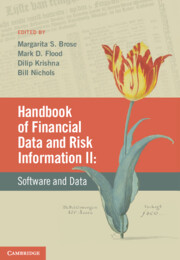Book contents
- Frontmatter
- Contents
- List of contributors
- Preface
- VOLUME II: SOFTWARE AND DATA
- PART IV DATA OPERATIONS IN FINANCIAL INSTITUTIONS
- PART V DATA MANAGEMENT TECHNOLOGIES
- 19 Financial data interchange standards
- 20 Data storage and processing
- 21 The extracting, transforming and transmitting of data
- 22 The visual analysis of financial data
- 23 Metadata management
- 24 Data security and privacy
- PART VI IMPLEMENTATION OF DATA AND ANALYTICS PROGRAMS
- Index – Volume II
21 - The extracting, transforming and transmitting of data
from PART V - DATA MANAGEMENT TECHNOLOGIES
- Frontmatter
- Contents
- List of contributors
- Preface
- VOLUME II: SOFTWARE AND DATA
- PART IV DATA OPERATIONS IN FINANCIAL INSTITUTIONS
- PART V DATA MANAGEMENT TECHNOLOGIES
- 19 Financial data interchange standards
- 20 Data storage and processing
- 21 The extracting, transforming and transmitting of data
- 22 The visual analysis of financial data
- 23 Metadata management
- 24 Data security and privacy
- PART VI IMPLEMENTATION OF DATA AND ANALYTICS PROGRAMS
- Index – Volume II
Summary
Introduction
Accurate and actionable information is a necessary condition to any capital markets activity, whether it means doing a trade, informing an investor, selling a product or complying with regulation around the instrument and transaction lifecycles. The absence of easily accessible, consolidated information has caused enormous problems in reporting and insight into the overall state of the business.
Product proliferation and regulatory demands continuously foster the need for new vendor content and software products. These need to be integrated with existing infrastructures in turn. This is one of the reasons why, if we look at an institution's data architecture from a bird's eye perspective, it typically looks like a maze of applications, databases, reports, data feeds and point to point interfaces. New reports often get bolted onto existing processing, new data feeds are plugged in to feed existing applications and the processing in between more often than not is a mix of legacy systems interspersed with vertical silo applications.
Between the places of origin of financial information such as market makers, research agencies, exchanges and issuing parties and the ultimate users (whether end users or business systems), there typically is a convoluted information supply chain. This supply chain includes different intermediaries between the ultimate source and the point of consumption, including information aggregators, validation, data enrichment and distribution functions.
- Type
- Chapter
- Information
- Handbook of Financial Data and Risk Information IISoftware and Data, pp. 251 - 278Publisher: Cambridge University PressPrint publication year: 2014



